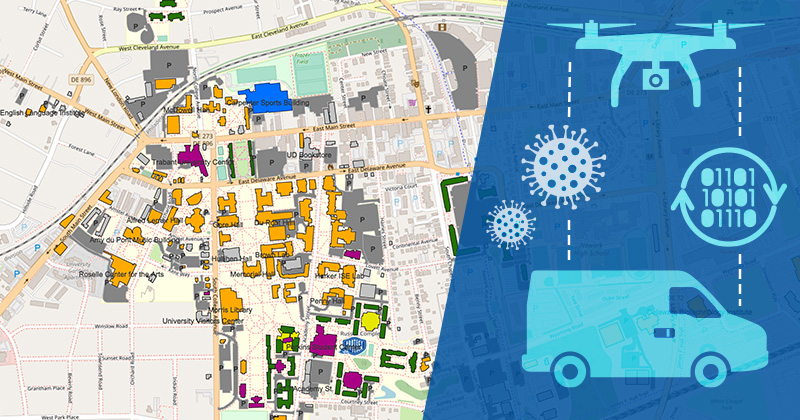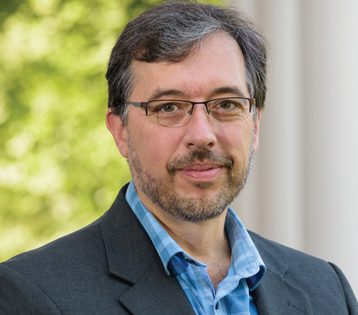


Preventing COVID’s spread on campus
December 04, 2020
UD research team’s predictive model includes what most don’t: student behavior
It’s a busy morning on campus and students are gathering at a crosswalk waiting for the traffic light to change. More than half have face masks on. What will happen to this group if one of the students who is not wearing a face mask is infected with the coronavirus (COVID-19)?
University campuses around the nation have been grappling with such scenarios and questions. To get answers, researchers from the University of Delaware are combining aerial observation with artificial intelligence to model how students are interacting with others on campus and in the surrounding community.
Norman Wagner, professor in UD’s College of Engineering, hopes the modeling effort, named Project Darien, will help students see the potential impacts of their actions and help inform health policymakers, while further advancing UD’s “Protect the Flock” campaign to prevent the spread of the coronavirus both on and off campus.

UD has experienced relatively low COVID-19 transmission rates compared to many of its peers during fall semester. A public dashboard provides daily reports of campus cases. University officials hope to welcome more students back to campus for the spring 2021 semester.
“We want to provide new tools that will help develop strategies for mitigating and eventually eliminating the novel coronavirus, as well as future biological threats,” said Wagner, an internationally known scholar and inventor, who is the Unidel Robert L. Pigford Chair in Chemical and Biomolecular Engineering at UD and this year’s Alison Professor.
“Many of the models out there are very basic,” Wagner explained. “They may tell you how many people are getting sick. But they don’t tell you what people are actually doing, how they are interacting. Are they wearing face masks? Are they staying at least 6 feet apart? Our model aims to address that behavioral dimension.”
In the scenario where a crowd of students is waiting for the light to change at a crosswalk, a range of policy recommendations could arise if such locations proved to be transmission “hotspots,” Wagner said, from doubling down on wearing face masks by placing reminder signage in such locations, to staggering the start time for classes, or halting vehicular traffic temporarily during peak times, allowing people to keep moving through intersections.
Co-leading the project with Wagner are Antony Beris, Arthur B. Metzner Professor of Chemical and Biomolecular Engineering, an expert on the thermodynamics of flowing systems who previously has collaborated with Wagner in the development of sophisticated modeling tools, and Rick Suminski, associate professor of health, behavior and nutrition in the College of Health Sciences and director of the Center for Innovative Health Research.
The research is funded by the National Science Foundation through its Rapid Response Research (RAPID) program aimed at COVID-19.
Project Darien
When Wagner saw a College of Health Sciences van pull into the driveway next door to his home on Darien Road this past summer, he was intrigued. He had never seen the mobile research unit before. Suminski hopped out, and soon the seeds of collaboration got planted and “Project Darien” was born.
Suminski typically uses the van to collect health data in Wilmington, Philadelphia and other urban areas, but now Newark residents might see the van in their neighborhoods. Data are being gathered on UD’s North Campus and in surrounding areas using a combination of drones and stationary cameras and also by research team members wearing smart glasses. The video that is captured is blurred so that individuals can’t be identified, Suminski said.
Artificial intelligence algorithms written by associate scientist Matt Saponaro, who recently graduated from UD with his doctorate in computer science, are being used to rapidly analyze the big data. Algorithms are a set of mathematical instructions for computers that help these systems learn to mine specific data and recognize patterns. They can determine, for example, if someone is wearing a face mask or detect individuals that the Centers for Disease Control has defined as being at increased risk of COVID-19 infection, such as older adults, people of color or people with limited mobility.
Saponaro is founder and CEO of A. I. Whoo LLC, a data-driven, artificial intelligence company. He recently received a $350,490 New Castle County CARES Act Innovation grant to develop a scalable infrastructure to support localized epidemiological models that inform policy and decision-making during the COVID-19 pandemic. This work will complement the Project Darien effort. Saponaro went through Horn Entrepreneurship’s Summer Founders program to develop a business model around the COVID-19 technology.
Suminski, like the rest of the team, wants the model to be an educational tool that delivers a clear message. “The model will allow you to change from 80% to 20% compliance in wearing face masks, for example, and see how your COVID-19 infection rates go up,” he said. “Like a breathalyzer test — if the levels are too high, it’s time to put the locks on the car.”
“All the research I do is to help people,” Suminski added. “I have little kids and an 82-year-old mom. Preventative behavior starts with education.”
The research team is developing an epidemiological dashboard, and they are working to incorporate real-time weather data, including wind speed and direction, since the COVID-19 virus is aerosolized. As they refine the program, the team wants users to try it out to better understand how COVID-19 is spread and the effects of various personal and public policies.
“We really want students to use the model to inform themselves how their actions and that of their classmates affect others under COVID-19,” Wagner said.
The model, which was built with NETLOGO, an open-access software, is accessible from this webpage or by downloading the program. The simulation takes into account the typical schedule students might have on a given day, Wagner said, including attending classes and engaging in various recreational and extracurricular activities.
“Our goal is not to ‘gamify’ this disease, but to educate people and provide tools for health policy,” Wagner said. “COVID-19 has already killed over a million people. We really need to come to scientific grips with this virus transmission problem if we’re going to protect people from this disease and future public health crises.”
Wagner, Suminski, co-workers and the talented graduate and undergraduate students involved in the project are grateful for financial support by the National Science Foundation through the RAPID program, the support of leadership broadly across the campus community for providing data necessary for the project, and for the leadership and support of UD’s coronavirus taskforce to make the project possible.
Contact Us
Have a UDaily story idea?
Contact us at ocm@udel.edu
Members of the press
Contact us at 302-831-NEWS or visit the Media Relations website

